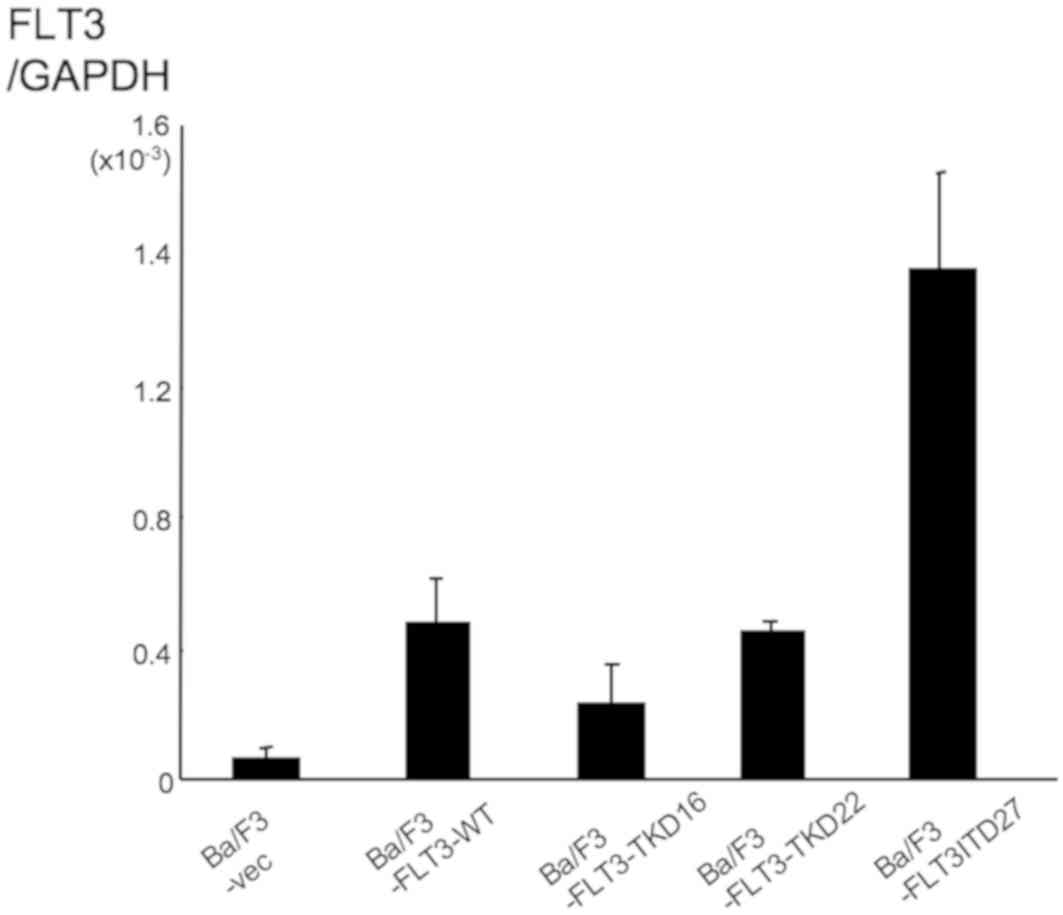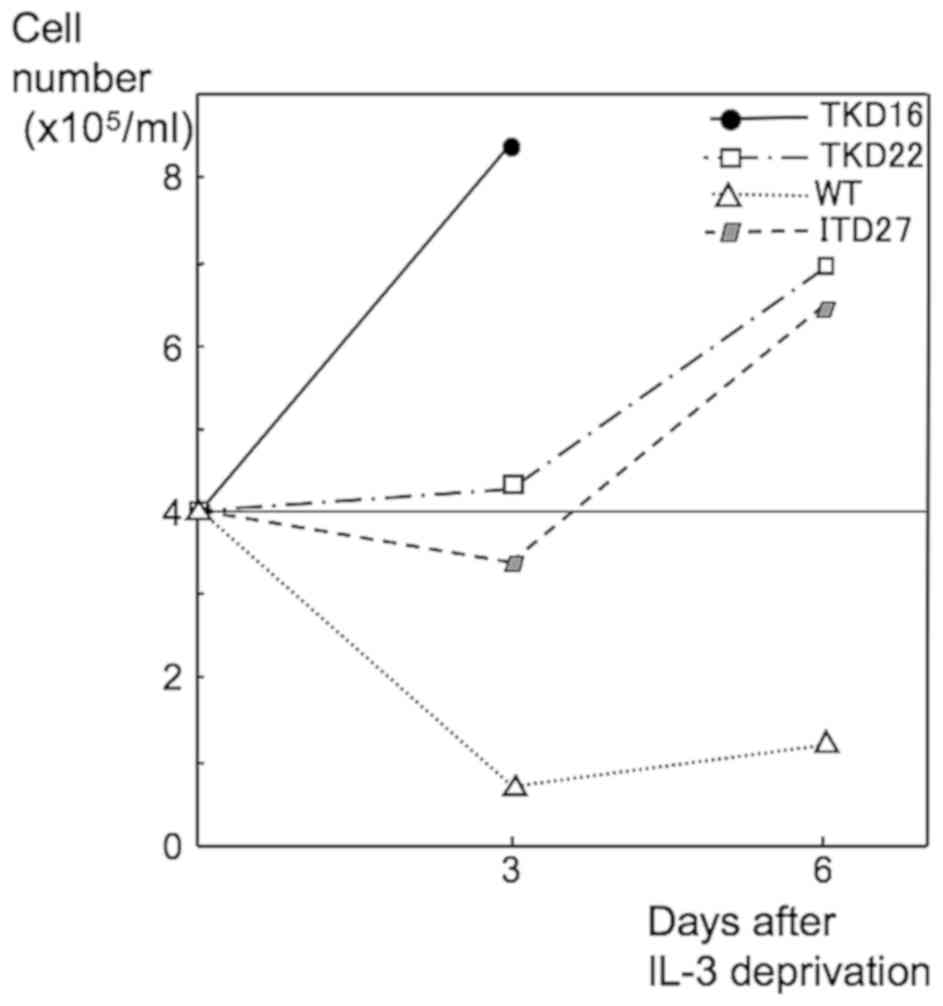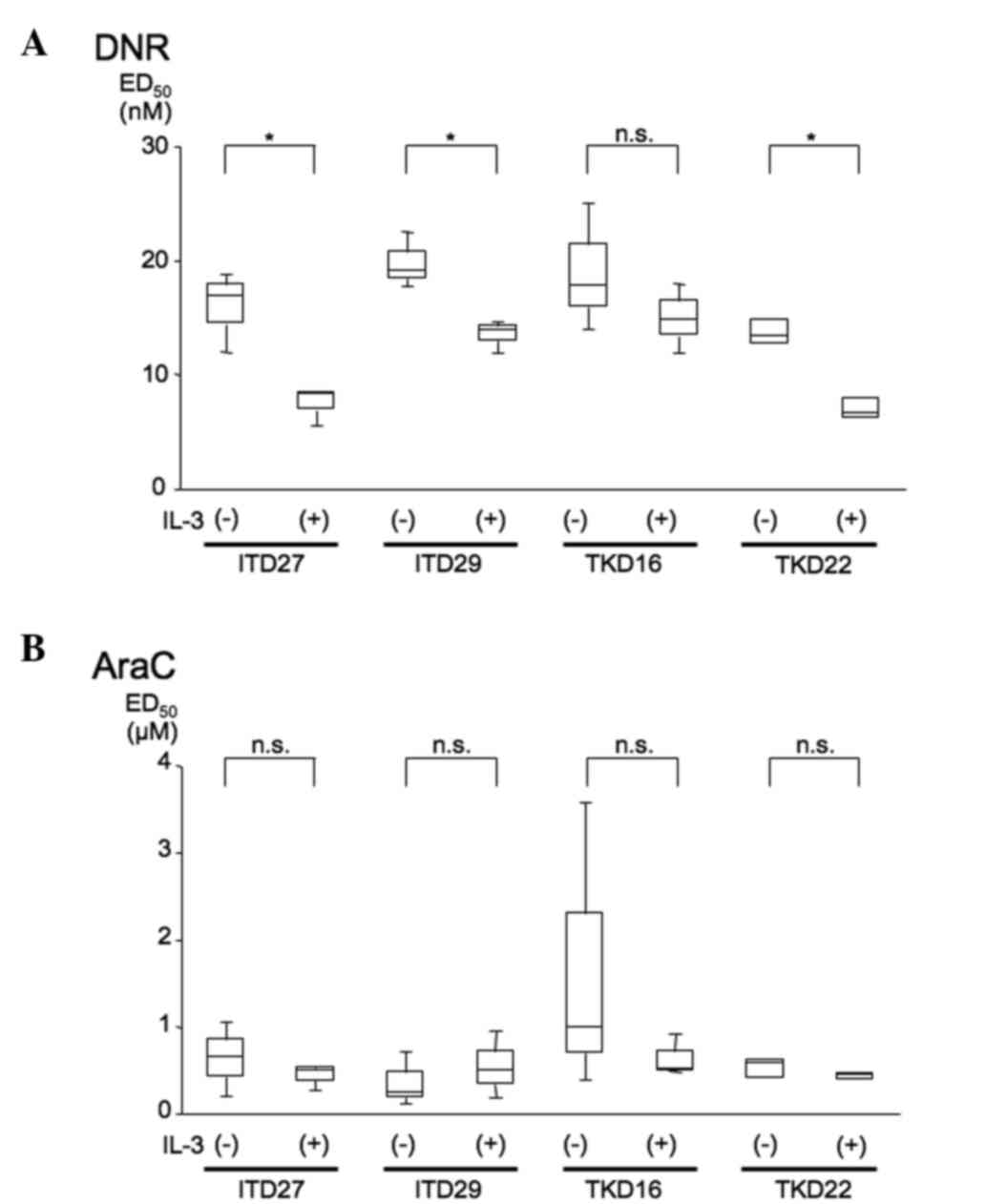Internal tandem duplication and tyrosine kinase domain mutations in FLT3 alter the response to daunorubicin in Ba/F3 cells
- Authors:
- Published online on: November 9, 2015 https://doi.org/10.3892/br.2015.541
- Pages: 83-86
Abstract
Introduction
Fms-like tyrosine kinase 3 (FLT3) is a member of the class III receptor tyrosine kinase receptor family (1) and is the most frequently mutated gene (20–30%) in acute myelogenous leukemia (AML) (2–4). Activating mutations, as well as overexpression of FLT3, are prevalent in AML, with a role in leukemogenesis (3,5–8). In adult AML, ~24% of such mutations are internal tandem duplications (ITD) in the juxtamembrane domain (2,3), which result in ligand-independent dimerization and tyrosine phosphorylation of the receptor (9). In addition, activating point mutations in the FLT3 tyrosine kinase domain (TKD; FLT3-TKD), mainly at aspartic acid 835, are identified in ~7% of AML patients (10).
ITD in FLT3 (FLT3-ITD) is associated with a higher leukocyte count, increased relapse risk, decreased disease-free survival (DFS) and decreased overall survival (OS) (11). Furthermore, multivariate analyses have shown that FLT3-ITD is the most significant factor for predicting an adverse outcome in AML (11–14). By contrast, FLT3-TKD mutations have a smaller effect compared with FLT3-ITD, but tend to worsen the DFS and OS (10), with the differences being statistically significant for OS in patients aged ≤60 years (15).
FLT3-ITD alters chemotherapy responses in vitro and in vivo and confers resistance to doxorubicin, which depends on p53 (16). Additionally, DNA repair contributes to the FLT3-ITD drug-resistant phenotype of primary AML (17). Several studies demonstrate drug resistance conferred by FLT3-ITD (16,18,19); however, thus far, no studies have demonstrated the effect of mutations in the FLT3 TKD on anticancer drug resistance.
The present study examined the effects of FLT3-ITD and FLT3-TKD on cytotoxic drugs by employing an IL-3 dependent cell line, Ba/F3. In this cell line, interleukin-3 (IL-3)-independent cell growth occurs in response to stably transduced oncogenic signaling, such as via FLT3-ITD and -TKD (20). This system was used to evaluate the effect of FLT3-ITD and -TKD oncogenic signals on the cytotoxicity of daunorubicin (DNR) and cytarabine (Ara-C). As a result, FLT3-ITD and -TKD signals were observed to alter the response to DNR.
Materials and methods
Generation of Ba/F3 cells expressing FLT3-ITD and FLT3-TKD
Our previous studies established the Ba/F3 FLT3-WT and-ITD cells (6,21). To generate stably expressing Ba/F3-FLT3-TKD cells, pcDNA FLT3-TKD (D835Y) was generated using pcDNAFLT3-WT (6) and the Quick change site directed mutagenesis kit XL (Stratagene, La Jolla, CA, USA) with the following primers: Sense, 5′-CTTTGGATTGGCTCGATATATCATGAGTGATTC-3′ and anti-sense, 5′-GAATCACTCATGATATATCGAGCCAATCCAAAG-3′. The construct was confirmed by sequence analysis and transfected into Ba/F3 cells using a CLB-Transfection device (Lonza, Basel, Switzerland). Stably transfected Ba/F3 clones were isolated by limiting dilution and selection with 400 µg/ml neomycin in RPMI (Gibco BRL, Thermo Fisher Scientific, Rockville, MD, USA) containing 10% heat-inactivated fetal bovine serum, 100 ng/ml recombinant mouse IL-3 (R&D Systems, Minneapolis, MN, USA) and 50 µmol/l 2-mercaptoethanol. Cells were cultured at 37°C in a humidified 5% CO2 atmosphere.
mRNA analysis
cDNA was prepared from cells using reverse transcriptase (Transcriptor First Strand cDNA Synthesis kit; Roche, Indianapolis, IN, USA). Reverse transcription-quantitative polymerase chain reaction (RT-qPCR) was performed using the Quantitect SYBR-Green PCR reagent (Qiagen, Miami, FL, USA) according to the manufacturer's protocol and using an Opticon Mini Real-time PCR Instrument (Bio-Rad, Hercules, CA, USA), as described previously (22). The primer sequences were: FLT3 forward, 5′-TCAAGTGCTGTGCATACAATTCCC-3′ and reverse, 5′-CACCTGTACCATCTGTAGCTGGCT-3′; and GAPDH forward, 5′-GAAGGTGAAGGTCGGAGT-3′ and reverse; 5′-GAAGATGGTGATGGGATTTC-3′. The thermal cycling conditions for FLT3 and GAPDH were incubation at 95°C for 15 min, followed by 35 cycles of 95°C for 30 sec, 55°C for 30 sec and 72°C for 45 sec. The copy number of each sample was calculated as previously described (21).
Assessment of viable cells
The proportion of viable cells was determined using a dye reduction assay involving a tetrazolium salt, 2-(2-methoxy-4-nitrophenyl)-3-(4-nitro- phenyl)-5-(2,4-disulfophenyl)-2H-tetrazolium, monosodium salt (WST-8; Dojindo, Tokyo, Japan), which is a modification of the 3-(4,5-dimethylthiazol-2-yl)-2,5-diphenyltetrazolim assay. The effective dose (ED)50 values were calculated from the data obtained from the cell growth assays. Exponentially growing cells were seeded at 1×104 cells per well in flat-bottomed 96-well plates, with or without IL-3 in the medium. Seven different doses were selected for DNR (Sigma, St. Louis, MO, USA) (1.5, 3.1, 6.2, 12.5, 25, 50 and 100 nM) and Ara-C (Sigma) (0.15, 0.31, 0.62, 1.25. 2.5, 5 and 10 µM). No DNR or Ara-C was added to the controls cells. Assays were performed 2 days after the addition of the drugs. For IL-3(−) cells, exponentially growing cells were washed twice with phosphate-buffered saline and seeded without IL-3. Viable cells (%) were calculated as the ratio of the absorbance (490 nm) of DNR or Ara-C-treated cells to the absorbance of untreated cells. At least three independent experiments were performed. The calculated ratios were analyzed and the ED50 values were obtained using tools at http://www.vector.co.jp/soft/win95/edu/se248471.html.
Statistical analysis
Data are expressed as the mean ± standard error of the mean and P<0.05 (denoted by one asterisk) was considered to indicate a statistically significant difference. Comparison of the means was performed using Student's t-test (http://www.physics.csbsju.edu/stats/t-test_bulk_form.html).
Results
Generation of Ba/F3-FLT3-TKD cells
Our previous study established the generation of Ba/F3-FLT3-ITD cells (21), and for the present study, to clarify whether FLT3-ITD or FLT3-TKD mediate any specific anticancer drug effects, Ba/F3-FLT3-TKD cells were also generated. The pcDNA FLT3-TKD (D835Y) vector was electroporated into Ba/F3 cells and stably transfected lines were isolated by limiting dilution with medium containing neomycin. Among >20 lines obtained, two clones, Ba/F3-FLT3-TKD16 and Ba/F3-FLT3-TKD22, exhibited increased levels of FLT3 expression compared with the parental vector (pcDNA3.1) transfected Ba/F3-vec cells (Fig. 1). To confirm that the FLT3-TKD transgene was functionally active, Ba/F3-FLT3-TKD16 and Ba/F3-FLT3-TKD22 cells were deprived of IL-3. These two lines showed factor-independent growth, as previously reported (21,23). Similar growth was observed for Ba/F3-FLT3-ITD (positive control), but not for Ba/F3-FLT3-WT (negative control) (Fig. 2).
ED50 of DNR increases in IL-3-deprived Ba/F3-FLT3-ITD27, -ITD29 and -TKD22 cells
Cell viability and ED50 values were examined in the Ba/F3-FLT3-ITD and Ba/F3-FLT3-TKD cells. In Ba/F3-FLT3-ITD27, -ITD29 and -TKD22 cells, the ED50 value was significantly increased in the absence of IL-3, compared with the controls (Fig. 3A). Additionally, in Ba/F3-FLT3-TKD16 cells, the median value was higher [IL-3(−), 17.7 nM; IL-3(+), 14.8 nM], although this difference was not statistically significant (Fig. 3A). By contrast, there were no differences in the ED50 value for Ara-C between IL-3(−) and IL-3(+) cells (Fig. 3B). These results indicate that FLT3-ITD, as well as the mutation of the FLT3-TKD, may confer DNR resistance to Ba/F3 cells.
Discussion
The present data suggest that in AML patients with FLT3-ITD or FLT3-TKD mutations, DNR is not efficacious and only causes toxicity. This is consistent with the findings of a clinical trial showing that while the majority of AML patients benefit from intensified anthracycline dosing regimens, high-dose DNR did not provide a significant survival benefit in patients who had the FLT3-ITD mutation (24). Lee et al (25) also support this notion that FLT3-ITD causes resistance to doxorubicin; dual treatment of PML-RARα FLT3-ITD transgenic mice with FLT3 inhibitor SU11657 and doxorubicin increased sensitivity. Pardee et al (16) recently reported that FLT3-ITD confers resistance to doxorubicin in a p53-dependent manner. In addition to the well-known role of p53 in apoptosis induction, it has also been shown to induce multiple prosurvival and DNA repair genes (26). Consistent with this, FLT3-ITD-expressing AML cell lines and primary patient samples have increased the levels of reactive oxygen species, double-strand DNA breaks and increased DNA repair capacity (17,27).
The present findings are consistent with and support the above. However, using murine myeloid HF6 and human myeloid K562 cells, our previous study found that FLT3-ITD induced Ara-C resistance through repression of equilibrative nucleoside transporter 1 expression (19), which was not observed in the present study. This discrepancy may be due to the use of different cell lines. The present study employed Ba/F3 cells, a murine B-lymphoid cell line, which is distinct from HF6 and K562 cells. The Ba/F3 cells were used due to their IL-3 deprivation characteristic, which can reveal the effect of FLT3 oncogenic signals. This enabled a specific DNR response to be identified.
The study also highlights the FLT3-TKD mutations, which may confer resistance to anthracycline. Although the data are from a cell line model and are somewhat preliminary, these results may indicate the benefit of therapy combining anthracycline and FLT3 inhibitors for patients carrying FLT3-ITD and FLT3-TKD mutations.
Acknowledgements
The authors would like to thank Mr. Tatsuya Osaka and Mr. Wataru Nomura for establishing the cell lines and Ms. Hiroko Nakano for her technical assistance. The study was supported in part by Grants-in-Aid for Scientific Research (grant no. 26460685) from the Ministry of Education, Science and Culture (Japan), and the Takeda Sceince Foundation, a foundation from Kitasato University School of Allied Health Sciences (Grant-in-Aid for Research Project, no. 2015-1003). Edanz Group Ltd. (www.edanzediting.com) provided editorial assistance.
References
|
Rosnet O, Matteï MG, Marchetto S and Birnbaum D: Isolation and chromosomal localization of a novel FMS-like tyrosine kinase gene. Genomics. 9:380–385. 1991. View Article : Google Scholar : PubMed/NCBI | |
|
Yokota S, Kiyoi H, Nakao M, Iwai T, Misawa S, Okuda T, Sonoda Y, Abe T, Kahsima K, Matsuo Y and Naoe T: Internal tandem duplication of the FLT3 gene is preferentially seen in acute myeloid leukemia and myelodysplastic syndrome among various hematological malignancies. A study on a large series of patients and cell lines. Leukemia. 11:1605–1609. 1997. View Article : Google Scholar : PubMed/NCBI | |
|
Gilliland DG and Griffin JD: The roles of FLT3 in hematopoiesis and leukemia. Blood. 100:1532–1542. 2002. View Article : Google Scholar : PubMed/NCBI | |
|
Takahashi S: Downstream molecular pathways of FLT3 in the pathogenesis of acute myeloid leukemia: Biology and therapeutic implications. J Hematol Oncol. 4:132011. View Article : Google Scholar : PubMed/NCBI | |
|
Ozeki K, Kiyoi H, Hirose Y, Iwai M, Ninomiya M, Kodera Y, Miyawaki S, Kuriyama K, Shimazaki C, Akiyama H, et al: Biologic and clinical significance of the FLT3 transcript level in acute myeloid leukemia. Blood. 103:1901–1908. 2004. View Article : Google Scholar : PubMed/NCBI | |
|
Takahashi S, Harigae H, Ishii KK, Inomata M, Fujiwara T, Yokoyama H, Ishizawa K, Kameoka J, Licht JD, Sasaki T and Kaku M: Over-expression of Flt3 induces NF-kappaB pathway and increases the expression of IL-6. Leuk Res. 29:893–899. 2005. View Article : Google Scholar : PubMed/NCBI | |
|
Takahashi S, Harigae H, Kaku M, Sasaki T and Licht JD: Flt3 mutation activates p21 (WAF1/CIP1) gene expression through the action of STAT5. Biochem Biophys Res Commun. 316:85–92. 2004. View Article : Google Scholar : PubMed/NCBI | |
|
Takahashi S, McConnell MJ, Harigae H, Kaku M, Sasaki T, Melnick AM and Licht JD: The Flt3 internal tandem duplication mutant inhibits the function of transcriptional repressors by blocking interactions with SMRT. Blood. 103:4650–4658. 2004. View Article : Google Scholar : PubMed/NCBI | |
|
Kiyoi H, Ohno R, Ueda R, Saito H and Naoe T: Mechanism of constitutive activation of FLT3 with internal tandem duplication in the juxtamembrane domain. Oncogene. 21:2555–2563. 2002. View Article : Google Scholar : PubMed/NCBI | |
|
Yamamoto Y, Kiyoi H, Nakano Y, Suzuki R, Kodera Y, Miyawaki S, Asou N, Kuriyama K, Yagasaki F, Shimazaki C, et al: Activating mutation of D835 within the activation loop of FLT3 in human hematologic malignancies. Blood. 97:2434–2439. 2001. View Article : Google Scholar : PubMed/NCBI | |
|
Kottaridis PD, Gale RE, Frew ME, Harrison G, Langabeer SE, Belton AA, Walker H, Wheatley K, Bowen DT, Burnett AK, et al: The presence of a FLT3 internal tandem duplication in patients with acute myeloid leukemia (AML) adds important prognostic information to cytogenetic risk group and response to the first cycle of chemotherapy: Analysis of 854 patients from the United Kingdom medical research council AML 10 and 12 trials. Blood. 98:1752–1759. 2001. View Article : Google Scholar : PubMed/NCBI | |
|
Meshinchi S, Woods WG, Stirewalt DL, Sweetser DA, Buckley JD, Tjoa TK, Bernstein ID and Radich JP: Prevalence and prognostic significance of Flt3 internal tandem duplication in pediatric acute myeloid leukemia. Blood. 97:89–94. 2001. View Article : Google Scholar : PubMed/NCBI | |
|
Kiyoi H, Naoe T, Nakano Y, Yokota S, Minami S, Miyawaki S, Asou N, Kuriyama K, Jinnai I, Shimazaki C, et al: Prognostic implication of FLT3 and N-RAS gene mutations in acute myeloid leukemia. Blood. 93:3074–3080. 1999.PubMed/NCBI | |
|
Frohling S, Schlenk RF, Breitruck J, Benner A, Kreitmeier S, Tobis K, Döhner H and Döhner K: AML Study Group Ulm. Acute myeloid leukemia: Prognostic significance of activating FLT3 mutations in younger adults (16 to 60 years) with acute myeloid leukemia and normal cytogenetics: A study of the AML Study Group Ulm. Blood. 100:4372–4380. 2002. View Article : Google Scholar : PubMed/NCBI | |
|
Thiede C, Steudel C, Mohr B, Schaich M, Schäkel U, Platzbecker U, Wermke M, Bornhäuser M, Ritter M, Neubauer A, et al: Analysis of FLT3-activating mutations in 979 patients with acute myelogenous leukemia: Association with FAB subtypes and identification of subgroups with poor prognosis. Blood. 99:4326–4335. 2002. View Article : Google Scholar : PubMed/NCBI | |
|
Pardee TS, Zuber J and Lowe SW: Flt3-ITD alters chemotherapy response in vitro and in vivo in a p53-dependent manner. Exp Hematol. 39:473.e4–485.e4. 2011. View Article : Google Scholar | |
|
Seedhouse CH, Hunter HM, Lloyd-Lewis B, Massip AM, Pallis M, Carter GI, Grundy M, Shang S and Russell NH: DNA repair contributes to the drug-resistant phenotype of primary acute myeloid leukaemia cells with FLT3 internal tandem duplications and is reversed by the FLT3 inhibitor PKC412. Leukemia. 20:2130–2136. 2006. View Article : Google Scholar : PubMed/NCBI | |
|
Zwaan CM, Meshinchi S, Radich JP, Veerman AJ, Huismans DR, Munske L, Podleschny M, Hählen K, Pieters R, Zimmermann M, et al: FLT3 internal tandem duplication in 234 children with acute myeloid leukemia: Prognostic significance and relation to cellular drug resistance. Blood. 102:2387–2394. 2003. View Article : Google Scholar : PubMed/NCBI | |
|
Jin G, Matsushita H, Asai S, Tsukamoto H, Ono R, Nosaka T, Yahata T, Takahashi S and Miyachi H: FLT3-ITD induces ara-C resistance in myeloid leukemic cells through the repression of the ENT1 expression. Biochem Biophys Res Commun. 390:1001–1006. 2009. View Article : Google Scholar : PubMed/NCBI | |
|
Spiekermann K, Bagrintseva K, Schwab R, Schmieja K and Hiddemann W: Overexpression and constitutive activation of FLT3 induces STAT5 activation in primary acute myeloid leukemia blast cells. Clin Cancer Res. 9:2140–2150. 2003.PubMed/NCBI | |
|
Takahashi S, Harigae H, Kameoka J, Sasaki T and Kaku M: AML1B transcriptional repressor function is impaired by the Flt3 internal tandem duplication. Br J Haematol. 130:428–436. 2005. View Article : Google Scholar : PubMed/NCBI | |
|
Iseki Y, Nakahara M, Kubo M, Obata F, Harigae H and Takahashi S: Correlation of PU.1 and signal regulatory protein α1 expression in PU.1 transgenic K562 cells. Int J Mol Med. 29:319–323. 2012.PubMed/NCBI | |
|
Hayakawa F, Towatari M, Kiyoi H, Tanimoto M, Kitamura T, Saito H and Naoe T: Tandem-duplicated Flt3 constitutively activates STAT5 and MAP kinase and introduces autonomous cell growth in IL-3-dependent cell lines. Oncogene. 19:624–631. 2000. View Article : Google Scholar : PubMed/NCBI | |
|
Fernandez HF, Sun Z, Yao X, Litzow MR, Luger SM, Paietta EM, Racevskis J, Dewald GW, Ketterling RP, Bennett JM, et al: Anthracycline dose intensification in acute myeloid leukemia. N Engl J Med. 361:1249–1259. 2009. View Article : Google Scholar : PubMed/NCBI | |
|
Lee BD, Sevcikova S and Kogan SC: Dual treatment with FLT3 inhibitor SU11657 and doxorubicin increases survival of leukemic mice. Leuk Res. 31:1131–1134. 2007. View Article : Google Scholar : PubMed/NCBI | |
|
Janicke RU, Sohn D and Schulze-Osthoff K: The dark side of a tumor suppressor: Anti-apoptotic p53. Cell Death Differ. 15:959–976. 2008. View Article : Google Scholar : PubMed/NCBI | |
|
Sallmyr A, Fan J, Datta K, Kim KT, Grosu D, Shapiro P, Small D and Rassool F: Internal tandem duplication of FLT3 (FLT3/ITD) induces increased ROS production, DNA damage and misrepair: Implications for poor prognosis in AML. Blood. 111:3173–3182. 2008. View Article : Google Scholar : PubMed/NCBI |












